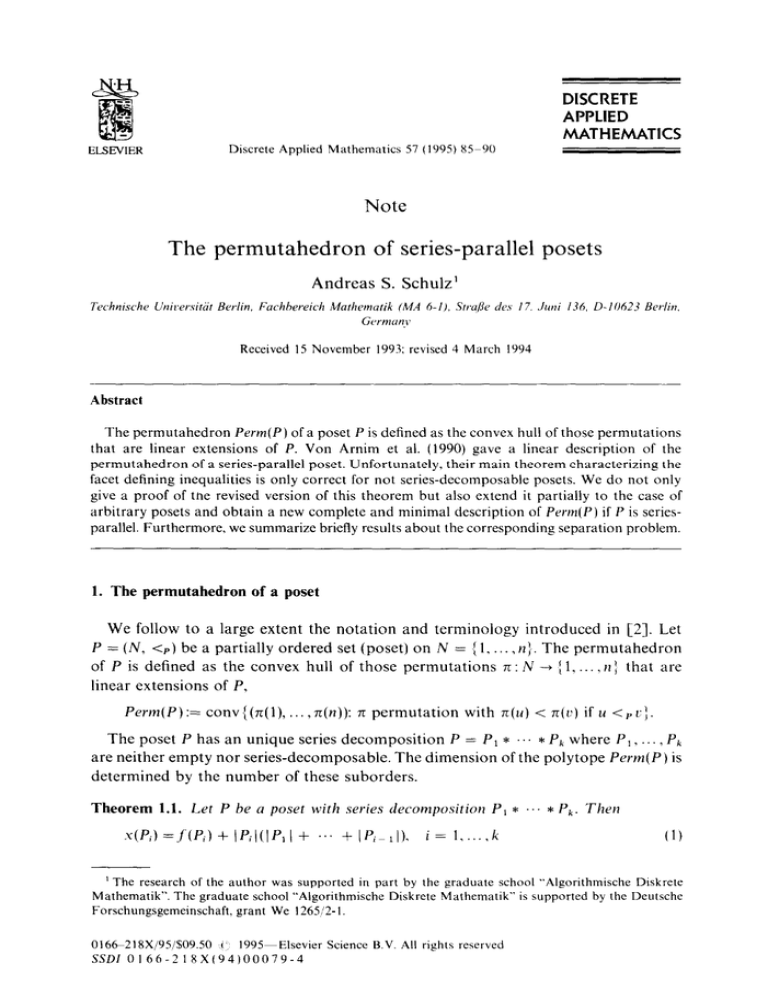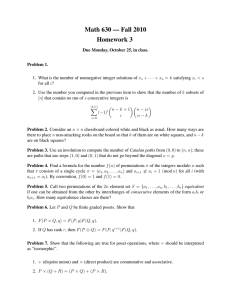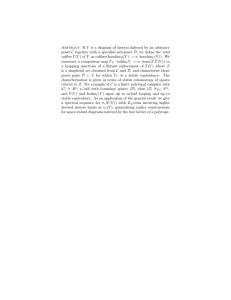
DISCRETE
APPLIED
MATHEMATICS
Discrete
ELSEVIER
Applied
Mathematics
57 (1995) X5-90
Note
The permutahedron
of series-parallel posets
Andreas
Technische
Uniwrsittit
Berlin,
Fachhereich
S. Schulz’
Mathematik
(MA 6-l),
Str-a/jr des 17. Juni
136, D-10623
Berlin.
Germun,,
Received
15 November
1993: revised 4 March
1994
Abstract
The permutahedron Perm(P) of a poset P is defined as the convex hull of those permutations
that are linear extensions of P. Von Arnim et al. (1990) gave a linear description of the
permutahedron
of a series-parallel poset. Unfortunately,
their main theorem characterizing
the
facet defining inequalities is only correct for not series-decomposable
posets. We do not only
give a proof of the revised version of this theorem but also extend it partially to the case of
arbitrary posets and obtain a new complete and minimal description of Perm(P) if P is seriesparallel. Furthermore, we summarize briefly results about the corresponding
separation problem.
1. The permutahedron
of a poset
We follow to a large extent
the notation
and terminology
introduced
in [2]. Let
P = (N, -+) be a partially ordered set (poset) on N = { 1.. . , PI). The permutahedron
of P is defined as the convex hull of those permutations
71: N -+ ( 1, . , n 1 that are
linear extensions of P,
Perm(P):=
conv((z(l),
,x(n)):
7~permutation
with Z(U) < z(u) if u <,c).
The poset P has an unique series decomposition
P = PI * ... * Pk where P, ,
, Pk
are neither empty nor series-decomposable.
The dimension of the polytope Perm(P) is
determined
by the number of these suborders.
Theorem 1.1. Let P be a poset
.u(Pi)=f’(Pi)
+ (Pi((lP,I
with series
+ “’
decomposition
+ lPi-11),
i=
PI * ... * Pk. Then
l,...,k
(1)
’ The research of the author was supported
in part by the graduate school “Algorithmische
Diskrete
Mathematik”.
The graduate school “Algorithmische
Diskrete Mathematik”
is supported by the Deutsche
Forschungsgemeinschaft.
grant We 1265./2-l
0166~218>(/95/$09.50
(’ 1995-Elsevier
SSDI 0 166-2
18X(94300079-4
Science B.V. All rights
reserved
86
A.S. Schulz /Discrete
Applied Mathematics
57 (1995) 85-90
is a maximal irredundant linear equation system for Perm(P), where f(S) := f (SI (I S 1+ 1)
for S E P.
Proof. First, observe that each linear extension z of P is the concatenation of linear
extensions ni of Pi, i.e. 72= (rci, . . . , zk) where each component of I is shifted by
[PI]+
*.. + 1Pi_ I (. Therefore, equation system (1) is valid with regard to Perm(P).
Obviously, the matrix of this equation system has full row rank. Thus, it remains to be
shown that for any equation ax = a satisfied by all linear extensions of P, there exists
k}. Let ax = Mbe such an equation and
~~R~suchthat&=a,forall~~Pi,i~(l,...,
letu,uforiE{l,...,
k} be two distinct elements of Pi. We have to show that a, = a,.
We consider two cases.
(i) Let u and v be incomparable. Then there exists a linear extension n of P such
that n(v) = n(u) + 1. Let 71 be the adjacent transposition of TLwith it(u) = n(v)
and E(v) = rc(u). Then it is also a linear extension
of P. Therefore,
0 = a71- a7T= (a, - a,)(n(v) - K(U)), i.e. a, = a,.
(ii) Now assume that u and u are comparable. It suffices to consider the case that
u is covered by u, i.e. there does not exist an element w E Pi\{u, u} with u -=c~w <p u.
Let U c Pi\{,} be the set of elements that are incomparable with u. Notice that
1U I > 1 since Pi is not series-decomposable. If there exists an element u”E U being also
incomparable with u, we get a, = a, = a, applying (i). Otherwise, each element of
U precedes v. Then let I’ be the set of those elements in Pi\(u} that are incomparable
with u. All elements of V are successors of u. Since Pi is not series-decomposable, there
exist two incomparable elements u”E U and v”E I/. Thus, using (i) again, we obtain
a,=a,=a,=a,.
0
Note that Theorem 1.1 holds for arbitrary posets. Therefore, it implies the following
extension of Theorem 4.3 of [2].
Corollary 1.2. Let P be a poset with series decomposition PI * ... *Pk. Then
dim(Perm(P))
= IP( - k
and there exist IPI - k + 1 linearly independent linear extensions of P.
2. Facet inducing ideal constraints
Von Arnim et al. [2] derived the following two classes of valid inequalities for
Perm(P): ideal constraints
x(l) 2 f(Z),
I c P is an ideal of P
and convex set constraints
JAlx(B)
- IBlx(A)
2
f(A((BI(IAJ + IElI),
A*B
c P convex.
A.S. Schulz / Discrete Applied Mathematics
5 7 (I 995) 85- 90
81
These two classes of inequalities together with the equation system (1) are sufficient to
describe Perm(P) completely if P is series-parallel (cf. [2]).
The following theorem corrects and extends Theorem 4.6(i) in [2] that is only
correct for posets that are not series-decomposable. Before stating it, we observe that
anyidealZcPisalwaysoftheformI=P,a.~.*Pi*~forsomei~{O,...,k-1)
where I^ is an ideal of the suborder Pi+ 1 and P has the series decomposition
P,* ... *Pk. Furthermore, such an ideal I induces a nontrivial and proper face of
Perm(P) if and only if t#tc I^ c Pi+ 1.
Theorem 2.1. Let P be a poset with series decomposition
PI * ... *Pk. An ideal
I=P~~~~~~Pi*~,i~{O,...,k-1},deJnesafacetofPerm(P)ifandonlyif~~I^~
Pi + , and both I^and Pi + 1\I^ are not series-decomposable.
Proof. The most important
observation for proving this theorem is the fact that the
face induced by an ideal I is itself the permutahedron of an appropriate poset. More
precisely,letQbetheposetdefinedbyQ:=P,*...*Pi*I^*(Pi+,\i)*Pi+,*...*P,.
Then
{x E Perm(P): x(l) =f(Z)}
Now Corollary
= PermCQ).
1.2 completes the proof.
0
The characterization of the facet defining ideal constraints as stated in Theorem 2.1
was independently obtained by von Arnim [l].
3. The series-parallel
case
Although it is possible to characterize those series-decomposable convex sets that
induce facets of the permutahedron of an arbitrary poset (cf. [3]), we restrict ourselves
here to the series-parallel case, just correcting Theorem 4.6(ii) of [2]. A seriesdecomposable set C = A * I3 E P is called bipartite if neither A nor B is itself seriesdecomposable.
Theorem 3.1. Let P be a series-parallel poset with series decomposition PI * ..’ *Pk.
A bipartite convex set C = A* B induces a facet of Perm(P) if and only if
(a) C c Pi, for some i E { 1, . . . , k}, or
(b) A =P<, B c Pi+l, for some iE(l,...,k-1)
and Pi+ 1\B is not series-decomposable, or
(c) A c Pi, B = Pi+l, for some i E { 1, . . , k - 1) and Pi\A is not series-decomposable.
88
‘4.S. Schulz /Discrete
Applied Mathematics
Proof. Let C = A *B be a bipartite
Suppose
that neither the set inclusion
(c) are valid. Not (a) implies
able
implies
that
convex
57 (1995) 85-90
set that
induces
a facet of Perm(P).
of (a) nor the set relationships
of(b) nor those of
that C $ Pi for all i E { 1, . . , k). Pi not series-decompos-
C # Pi. Since
C is convex
and
bipartite,
we have
A E Pi and
B s Pi+ifOrSOmeiE{l,...
, k - 11. Regarding not (b) and not (c), there are only two
possibilities, namely A c Pi and B c Pi+, , or A = Pi and B = Pi+ 1. From the latter
we obtain by Theorem
1.1 that every x E Perm(P) satisfies the inequality
under
consideration
with equality and therefore a contradiction.
In order to lead the other
case to a contradiction
we use
{x~Perm(P):
JAlx(B) - IBlx(A) =)lAljBl(lAj
+ /B/)} = Perm(Q),
(2)
where the extension
Q of P is defined as Q := PI * ... *(P,\A) *A * B*(P,+ ,\B)
* ... *Pk. Equation
(2) was already observed by von Arnim et al. Hence, using
Corollary
1.2 we obtain dim(Perm(Q))
,< n - k - 2, contradicting
our assumption.
Thus we have proved that C has to satisfy one of the set relationships
(a)-(c).
Therefore, the last observation
needed is that Pi+ 1\B in case (b) and Pi\A in case (c)
are not series-decomposable,
respectively. This follows also from Eq. (2), since otherwise Corollary 1.2 implies again that the respective convex set constraint defines no
facet.
For the converse direction we already know that (a) implies that C defines a facet.
This is due to von Arnim et al. In case (b) and (c) we consider once more the
corresponding
poset Q that satisfies (2). Since Pi+ l\B and Pi\A are not seriesdecomposable,
Corollary
1.2 implies that these convex set constraints
are facet
defining ones, respectively.
0
Note that Theorem 3.1 does not exclude that there are series-decomposable
convex
subsets of P which are not bipartite but facet defining. However, it is quite easy to
show that these facets are identical
to some of those mentioned
in Theorem
3.1.
There is another important
remark on the facet defining inequalities
of Theorems
2.1 and 3.1. They do not necessarily induce distinct facets. First, notice that C = Pi *B
is convex and bipartite
with Pi+ ,\B not series-decomposable
if and only if
I = PI * ... * Pi * B is an ideal with B and Pi + l\B not series-decomposable.
AnalogOUSly,D=A*Pi+l
is convex and bipartite with Pi\A not series-decomposable
if and
only if J = PI * ... *Pi_ 1 *(P;\A) is an ideal and both A and Pi\A are not seriesdecomposable.
If one remembers the proofs of Theorems 2.1 and 3.1, it is not hard to
see that the facets induced by C and I as well as those induced by D and J, respectively,
are identical. Observe further that all the other inequalities
characterized
in these
theorems induce mutually distinct facets.
Given a polyhedron
T = {x E R”: Ax 3 b$, there is at least one inequality ax 3 p of
the system Ax 3 b with F = {x E T: ax = fi) for each facet F of T. Furthermore,
T is
completely described by the system which is obtained by taking one of these inequalities for each facet together with a maximal irredundant
equation
system for T.
A.S. Schulz /Discrete
Therefore,
following
the above
observations
together
with
Theorem
3.3 of [2]
imply
the
theorem.
Theorem 3.2. Let P be u series-parallel
Then
89
Applied Mathematics 57 (1995) 85-90
the
following
linear
system
poset
with series
is a complete
and
decomposition
minimal
linear
P, * ... * P,.
description
of
Perm( P):
+lP;-I/),
x(Pi)=f(Pi)+IPiJ(IP1I+
...
x(I)
I( = PI * ... *Pi * r^,for some
>,f(I),
,for all ideals
i=
1, . . ..k.
and Pi+, \r^ not series-decomposable,
(Alx(B)
-
IBlx(A)
>+1Al1Bl(1,4
+ IBI),
A*B
someiE
i E {0, . . . , k - 1) ), r^
8 c I^ c
c
Pi cont’ex
Pi+ 1 ;
and bipurtite
for
[l, . . ..k).
4. The separation problem
The complete description of Perm(P) by means of linear equations and inequalities
leads naturally to the question how to solve the separation problem for a given point
in R” and Perm(P).
Queyranne
and Wang (cf. [4, 51) studied a closely related
full-dimensional
single machine scheduling polyhedron
P(N). They derived inequalities corresponding
to initial (ideal) and intermediate
(convex) sets, respectively, which
turn out to be identical to those mentioned
above when all job processing times are
equal to one. In this case Perm(P) is a proper face of P(N), and it is a facet if and only if
the poset P is not series-decomposable.
Queyranne
and Wang [S] proposed an O(n log n) separation-algorithm
for the class
of ideal constraints
that is based on sorting the components
of the given point for
which the separation
problem has to be solved. They adapted this algorithm to the
class of those convex sets A *B, where A or B is a singleton. It is even possible to
extend this idea to the case (A I = p or 1B 1= p where p is fixed, providing
algorithm.
Nevertheless,
in the case of a series-parallel
an O(nP’ ’ )
poset P it is easy to include
the
whole class of convex set constraints
using the binary decomposition
tree of P as
follows.
We are interested in series-decomposable
sets A * B. Thus, it is obviously sufficient
to consider only those tree nodes corresponding
to a series composition.
We consider
these nodes separately. The basic idea is now to fix the cardinalities
of A and B and to
compute for each possible combination
of these cardinalities
at the actual tree node
the difference between the left-hand side and the right-hand
side of the convex set
constraint built by the set of the biggest elements of the left subtree and the set of the
smallest elements of the right subtree. This is quite natural and the reader should be
able to fill in the details.
However, determining
the computational
complexity of the separation problem for
the class of convex set constraints
in the case of an arbitrary poset P remains an open
problem.
90
AS. Schulz / Discrete Applied Mathematics
57 (I 995) 85- 90
References
[1] A. von Amim, Das Permutaeder einer Ordnung, Ph.D. Thesis, Universitgt zu K6ln (1993).
[Z] A. von Amim, U. Faigle and R. Schrader, The permutahedron of series-parallel posets, Discrete Appl.
Math. 28 (1990) 3-9.
[3] A. von Arnim and AS. Schulz, Facets of the generalized permutahedron of a poset, Preprint 386/1994,
Fachbereich Mathematik, Technische Universitlt Berlin (1994).
[4] M. Queyranne and Y. Wang, Single-machine scheduling polyhedra with precedence constraints, Math.
Oper. Res. 16 (1991) l-20.
[S] M. Queyranne and Y. Wang, A cutting plane procedure for precedence-constrained single machine
scheduling, Working Paper, Faculty of Commerce, University of British Columbia, Vancouver, B.C.
(1991).



